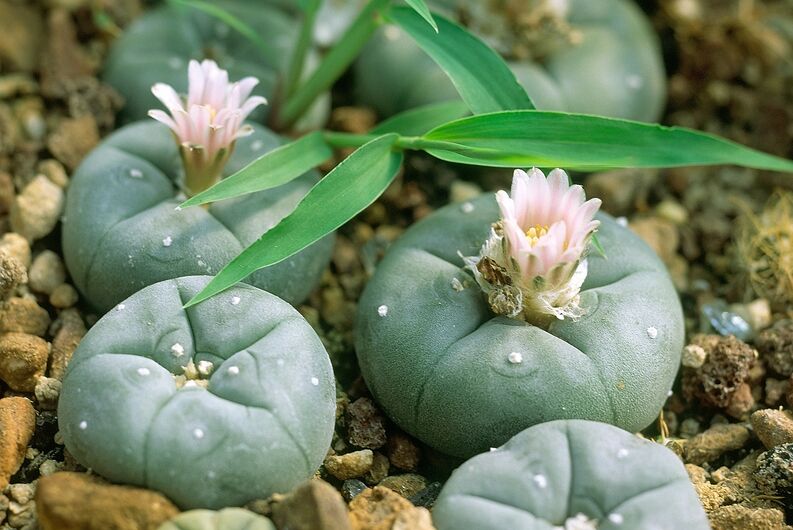What is Peyote?
Many people have heard of peyote, but no one is really clear on the substance, where it comes from, or the effects it has on users. Peyote is a cactus that is small in size, the buttons that the plant contains are disc-like in shape. These “buttons” are removed from the cactus and then either dried out and then used as a chew, or soaked in water. It was originally used by the Native Americans because of the alkaloids within the peyote are psychoactive. The Native Americans also believed there were medicinal uses from peyote.
The peyote plants grown on the ground, the cactus itself is either a yellow-green or blue-green in color. It grows as flat spheres that open during the daylight hours. The part that is edible is the fruit that comes from the cacti which is pink in color It takes a long time for this slow growing cactus to form.
The cactus is found In South Texas mostly, it can grow other places but it currently listed as an endangered species. Some of the slang terms used to describe peyote include buttons, mescal, nubs, tops, and mesc.
Brief History of Peyote
The history is said to go back more than 20,000 years with use being from the Native Americans and groups in Northern Mexico. It has been used in religion and also in medicine. There have been many battles over the years and throughout the history of peyote when it comes to legal use of the drug. It has been described as a satanic drug by early settlers and this caused a good amount of cultural controversy in early American times.
When the Native American Church was founded in the 19th century, the use of the cactus in religious ceremonies became more widespread and then was noticed by the U.S. government. When this happened, there were many efforts to ban the substance even though the Native Americans saw peyote as a connection between humans and God. The first time we saw peyote being used in American history was during the Civil War according to documentation.
Where is Peyote Found?
Peyote is seen and grown in Texas and some areas of North Mexico. It grows in areas where there are limestone, in scrub areas. The flowering season is from March to May, and as previously mentioned, the fruit itself is pink.
Peyote Uses
There are various reasons why people choose to be under the influence of peyote. The original reasoning was for medicine and as a part of religious ceremonies. Peyote is still used to treat illness and communication with spirits, it is also used in religion as communication with spirits to see the future.
When it comes to medical purposes, it is used by Native Americans for help with childbirth pain, diabetes, blindness, fever, and general pain. It has also been used for skin wounds and joint pain. Even though it is illegal outside of the Native American Church, other people are still using peyote.
The people who are generally using peyote outside of the Native American Church are using it to experience hallucinations, get away from the stress in their life, or to escape reality. People assumed because it is natural that it is safe, this is definitely not the case with peyote. It can be a very dangerous drug to ingest.
How is Peyote Used?
As with most drugs, there are a variety of ways to use the drug. The “buttons” are the dried tops of the plant. These can be brewed in tea, eaten, or crushed into a powder that can then be put into capsules. People also smoke the crushed leaf as they would with tobacco or marijuana. The powder that is crushed is called mescaline sulfate, and it is the purest form of mescaline. It is also the form that is potentially the most addictive.
During the legal peyote ceremonies include gatherings inside a shelter or teepee and it will be hosted by the medicine man. These ceremonies often include songs and chants as the peyote is passed around for use. In the center of most ceremonies there is a fire and a drum circle is usually involved. There are differences in various peyote ceremonies, but the basics are similar across various tribes.
Even though peyote is illegal except for use through the Native American church, there are a number of people who use it for recreational use at parties or in their homes. In the Native American culture, it is looked down upon to use this drug recreationally, and it is not approved. Native Americans are not in favor of people using it recreationally, however, because they feel like this takes away from its spiritual relevance and uses.
How Does Peyote Work?
In the United States, peyote is classified as a hallucinogen. Other drugs that may be recognized in the same substance and drug classification category are LSD and ayahuasca. Hallucinogens change the neural circuits within the user’s brain. The hallucinogens interact with prefrontal cortex within the brain. The prefrontal cortex is responsible for perception, cognition, arousal and mood.
The peyote “trip” can last up to 12 hours. It gives the user an altered sense of perception, thinking, and synesthesia which crosses over senses and makes the user experience hallucinations.
Is Peyote Addictive?
Peyote as a substance does not have specifically any physical aspects of dependence, but there are many users who become mentally addicted to the plant. So the chemical makeup of the drug is not addictive but people do get addicted to the experience. There are no withdrawal symptoms if the user stops using the drug suddenly. Psychological dependence can develop with peyote but physical dependence doesn’t.
Peyote Risks: What Are the Risks of Taking Peyote?
There are many dangers of taking peyote even though there is no physical dependence for the drug. There are a number of health risks.
The Danger is in the Hallucinogens
According to the National Institute on Drug Abuse hallucinogens impact the brain by changing the person’s perception of what is exactly happening. The hallucinations make people think they can see, feel, and hear sounds that aren’t there because of the effects the drug has on the prefrontal cortex.
When someone is on a trip, there is no way to know if they will have a pleasant experience or a bad one. When most individuals are taking hallucinogens like peyote, the users may use their rationality or the ability to communicate.
A good trip is usually an experience in once someone feels they feel pleasant, and they might feel as if they’re mentally stimulated or enlightened. On the other hand, a bad trip can be extremely scary or anxiety-producing or could lead the person to feel like they’re losing control, going crazy or dying.
To sum up the peyote effects, as well as effects of other hallucinogens. Peyote feels like a hallucinogenic mixed with a stimulant, so the user will be experiencing hallucinations while having a surge of energy in their body. With all of this going on, there is no way to know how each user will react under the influence. Hallucinogens can make individuals act very irrationally and out of behavior, there is great concern for odd behaviors when under the influence of peyote.
Peyote Signs, Symptoms & Side Effects
As we just mentioned, there is no telling what will specifically happen on a peyote trip. No one can predict how each individual responds to the hallucinogen. Even when the drug has been done before and there was a certain experience, the next time can be completely different. One of the scariest things about this drug is that every single trip can be different, some can be good and others bad. It is also extremely scary to lose control over perception and thoughts, it can lead people to do things they wouldn’t normally do. This can result in being in bad situations.
In addition to the unknown risks mentioned above, other physical peyote side effects include:
Nausea from ingestion of the drug, many say they vomited or had stomach pains after taking the plant.
Anxiety or complete fear
Rapid heart rate
Increased blood pressure
Elevated body temperature
Insomnia
Incoordination in movements also known as ataxia.
The signs mentioned above are not even meant to be considered in just a “bad trip”. There are even more heightened levels of paranoia and anxiety that can take place when an individual is experiencing a bad trip. It has even caused some to commit suicide or really hurt themselves. People also under use of the drug say they have experienced a loss of appetite so there is a great risk for dehydration.
Long-Term Side Effects of Peyote
Unlike most of the drugs on our site, peyote does not have as many dangerous long time effects as one would assume. Some of the signs someone is using peyote or has a problem with the hallucinogen can include:
Putting a lot of time and energy toward sourcing more peyote or taking it.
Taking higher doses or taking peyote more frequently.
Continuing to take peyote despite bad trips or adverse effects.
Failing to adhere to responsibilities or giving up things that were once a priority.
Using peyote in situations that could be particularly dangerous, such as when driving or while out in public.
Is Peyote Legal?
Unless you are in the Native American Church using it within a religious ceremony. Peyote is not legal in all states and territories of the U.S. It is legal for those within the Native American church, but only in the following states, and all of this has limited legality. These states are:
Arizona
Colorado
Idaho
Iowa
Kansas
Minnesota
Nevada
New Mexico
Oklahoma
Oregon
South Dakota
Texas
Wisconsin
Wyoming
In all the states listed above it is only permitted for religious uses by the Native American Church. In the general sense peyote used recreationally is always illegal.
Help for Peyote Abuse
If you or someone you know is struggling with abusing Peyote. There is help. The PHP and IOP levels of care provided by The Best Treatment is important because in order to prevent relapse it is suggested a 60-90 day rehabilitation process is completed. We offer an individualized treatment program because it is essential to begin treating the root causes of drug use and addiction and everyone’s care is different.

